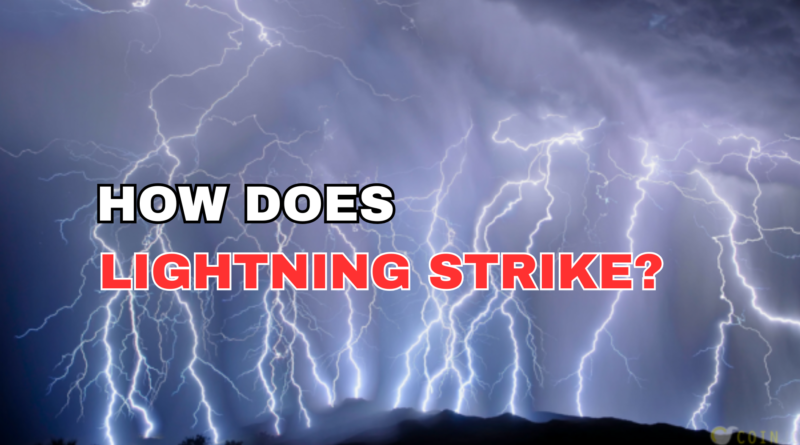HOW DOES LIGHTNING STRIKE?
Lightning is one of the most powerful and beautiful forces of nature. It is a sudden flash of light that we often see during thunderstorms. But have you ever wondered how lightning strikes? Let’s understand how it happens in a simple way.
What is Lightning?
Lightning is a huge electrical spark that happens in the sky. It is caused by an imbalance between positive and negative charges in the atmosphere. Lightning can happen inside a cloud, between clouds, or between a cloud and the ground.
Why Do Clouds Create Lightning?
Storm clouds, especially the tall ones called cumulonimbus clouds, are the main reason behind lightning. These clouds are formed when warm, moist air rises up into the sky and cools down, creating large clouds. Inside these clouds, there is a lot of movement of air, water droplets, and ice particles.
As the cloud grows taller, it becomes a mix of rain, snow, and ice. These particles bump into each other as they move. When they bump, they create electric charges. Small ice crystals get positive charges, while larger ice or water droplets get negative charges.
The lighter, positive particles float to the top of the cloud. The heavier, negatively charged particles sink to the bottom. This separation of charges creates a strong electric field inside the cloud.
How Lightning Reaches the Ground
Now, when the bottom of the cloud becomes very negatively charged, it starts affecting the ground below. It pushes away negative charges in the ground and pulls up positive charges to the surface—especially to tall objects like trees, buildings, poles, or even people.
When the difference between the cloud and the ground becomes too big, the air can no longer hold back the electricity. That’s when the lightning strike happens.
The Steps of a Lightning Strike
Lightning does not happen in a single step. It is actually a process. Let’s break it down:
1. Stepped Leader
The lightning process begins with something called a stepped leader. It is a small path of negative charge that moves down from the cloud in small steps. Each step is about 50 meters long. The leader moves fast and invisible to our eyes. It looks for the easiest path to reach the ground.
2. Streamer
When the stepped leader gets close to the ground, the positive charges on the ground try to meet it. A positive charge (called a streamer) rises up to meet the leader from tall objects like trees or buildings.
3. Connection
When the stepped leader and the streamer meet, they connect. This connection makes a complete path between the cloud and the ground.
4. Return Stroke
Once the connection is made, a strong bolt of electricity—called the return stroke—rushes from the ground up to the cloud. This is the bright flash we see as lightning. It travels extremely fast and heats the air around it to temperatures hotter than the surface of the sun.
5. Multiple Strikes
Sometimes, the lightning bolt doesn’t just strike once. The process can repeat a few times, and we may see the bolt flicker. Each flicker is another return stroke.
Types of Lightning
There are several types of lightning based on where it strikes:
Cloud-to-Ground (CG) Lightning: This is the most dangerous kind. It travels from a cloud to the ground.
Intra-Cloud (IC) Lightning: This stays within a single cloud and is the most common.
Cloud-to-Cloud (CC) Lightning: This happens between two separate clouds.
Ground-to-Cloud Lightning: Sometimes the charge starts from the ground and goes upward to the cloud.
Thunder and Lightning
Have you noticed that you always hear thunder after you see lightning? That’s because light travels faster than sound. The bright flash reaches your eyes first. Then you hear the loud boom of thunder. Thunder is caused by the sudden heating and expansion of air around the lightning bolt.
You can estimate how far the lightning struck by counting the seconds between the flash and the thunder. Every 3 seconds is about 1 kilometer (or 5 seconds per mile).
Is Lightning Dangerous?
Yes, lightning can be very dangerous. It can start fires, damage buildings, and harm or even kill people and animals. Each lightning bolt carries a huge amount of electricity. It can heat the air up to 30,000°C (about 54,000°F).
How to Stay Safe During a Thunderstorm
Stay indoors if you hear thunder or see lightning.
Avoid open fields, tall trees, and metal objects.
Don’t use wired electronics or take a shower during a storm.
If you are outside and can’t get inside, crouch down low-but don’t lie flat.
Interesting Facts About Lightning
Lightning strikes the Earth about 8 million times a day.
A single bolt can have up to 1 billion volts of electricity.
Lightning is hotter than the sun.
There is more lightning around the equator because it’s warmer.




